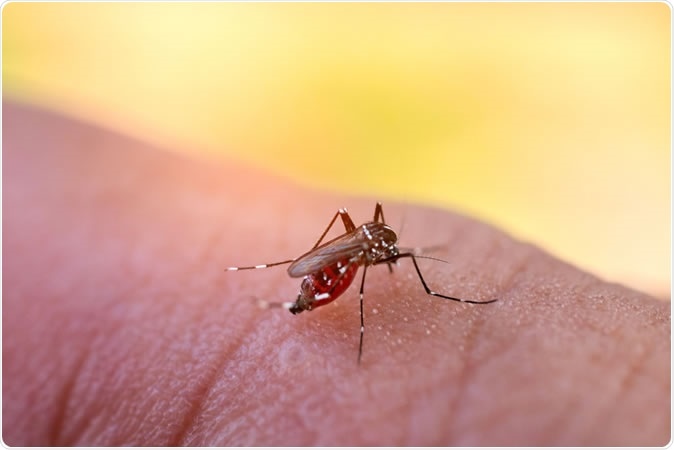This will help researchers understand how dengue spreads, the chief routes of spread, and the reporting rates in different countries. This in turn will help public health authorities to wisely use their resources to prevent dengue spread in countries where it is not yet a problem.

Aedes aegypti, the yellow fever mosquito, is a mosquito that can spread dengue fever, chikungunya, Zika fever, Mayaro and yellow fever viruses, and other disease agents. The mosquito can be recognized by white markings on its legs and a marking in the form of a lyre on the upper surface of its thorax. This mosquito originated in Africa, but is now found in tropical, subtropical and temperate regions throughout the world. Image credit: Thammanoon Khamchalee / Shutterstock
The problem
It is estimated that about 50% of the global population is at risk of catching dengue fever. Many cases are spread by incoming travellers from endemic countries, and this causes not only a quicker than otherwise expected spread, but also a possibly large-scale transmission.
Air travel has been a boon to many who need to reach their destination urgently. On the other hand, it has also become a high-risk route of disease importation, connecting endemic and non-endemic countries indiscriminately. For instance, air passengers who carried Zika virus in their blood were found to be a major cause for the spread of the disease from Brazil to the rest of the world in 2016.
Dengue reporting rates
Dengue causes about 50-100 million people to fall sick every year and is by far the biggest mosquito-borne disease in the world. Despite this staggering figure, reporting of dengue is extremely substandard, and only about 10% of these infections are reported to health authorities. Local outbreaks can occur in non-endemic countries both due to the fast spread via global airways, and the non-reporting of dengue cases. Such episodes usually occur because of a person who got the virus from abroad.
The only way to block these outbreaks is to predict disease importation from overseas and take proactive measures to limit the occurrence of outbreaks. Such predictive models are few, and those that have been developed are limited by their assumptions and premises in many ways.
The study
The current study is part of the Disease Networks and Mobility (DiNeMo) project that is creating a real-time surveillance and alerting system to warn of infectious diseases in humans, beginning with dengue. It is aimed at preventing the development of dengue foci in non-endemic countries, by establishing a model to predict the air-travel-mediated spread of dengue.
The researchers developed a network model that is based on the volume of global air passengers and combining this with dengue incidence rates for each country, as well as the season when dengue infections peak. Using International Air Transportation Association (IATA) data to acquire a picture of how air passengers actually move. The Global Health Data Exchange database was mined to acquire information on the dengue incidence per month for each country, and this was combined with seasonally reported fluctuations in dengue incidence.
The scientists then differentiated returning citizens or residents of the country from visitors, since the time spent in an endemic country by people in these two groups varies greatly, and therefore so does the risk of acquiring dengue.
Predicting number of infected arrivals
Using all this information, the model tells the estimated absolute number of dengue cases arriving each month at any given airport. For instance, when it was run across two years, the model predicted a high risk of dengue in Florida based on this parameter.
The model also tells us how many infected people travel between two given airports, which will show the most highly traveled routes of importation. Florida acquires most cases from the Caribbean (think Puerto Rico), which are endemic countries very close by, and from Latin America, thus showing two distinct peaks of dengue.
This can be adapted quite easily to predict the same thing with malaria, Zika or other vector-borne diseases.
Predicting region-wise reporting rates
The second important contribution the scientists made was to predict the reporting rates for each segment of time for each region. The reporting rate is the ratio of the reported number of infections to the actual number. Unlike cohort-based studies and the like, which are not only costly but sometimes inaccurate, this can be used to arrive at a reliable estimate of actual dengue incidence.
Incidence rates for dengue vary a lot between regions of the same country, especially if one area is tourism-centered and consequently the target of much dengue prevention and surveillance campaigning. Using this knowledge could further improve the accuracy of the model.
Implications
Other parameters should include the time spent on average in a country, which has been shown to be the most important. The type of housing, and the climate conditions in the non-endemic country are also variables that can improve the modeling results. In some cases, cold countries do not allow dengue virus transmission in some seasons as the mosquito vector cannot survive and breed during this time. Other modes of importation via alternative means of travel could also be studied.
Researcher Cassie Jansen says, “This provides a useful tool to assist public health authorities with dengue preparedness. It can also help authorities to identify those locations where new dengue outbreaks may occur, following the arrival of infected passengers."
Journal reference:
A global model for predicting the arrival of imported dengue infections. Jessica Liebig, Cassie Jansen, Dean Paini, Lauren Gardner, and Raja Jurdak. PLOS ONE, December 4, 2019. https://doi.org/10.1371/journal.pone.0225193. https://journals.plos.org/plosone/article?id=10.1371/journal.pone.0225193